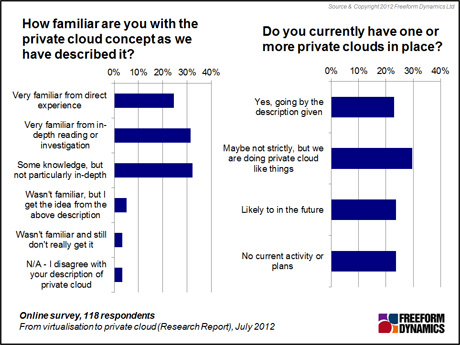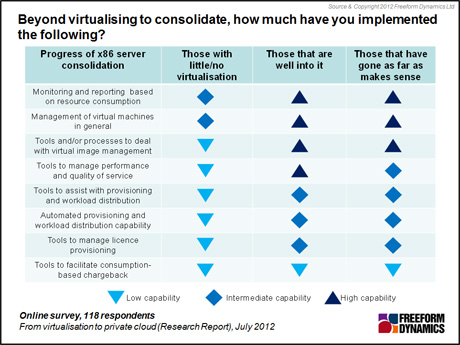Identifying the ingredients that make the difference for agile IT
The term ‘Private Cloud’ is widely marketed by IT vendors as the natural future of IT. Much of the messaging and promotional literature is designed assuming that companies have an understanding of, and intrinsic need for, a complete private cloud.
Yet our research indicates that very few companies actually set out with a vision to implement a private cloud with all the trimmings. Instead, most are looking to improve short term, acute pain points such as a lack of agility, improve service quality or performance, reduce the ongoing cost of operations, enhance the reliability of systems or modify ineffective change management.
The upshot of this is that while the community of private cloud vendors are going all out trying to get their networks of partners to sell complete private cloud solutions, this ‘all encompassing’ message and approach will likely find limited traction in the broader market.
This is not to say that the concept of ‘private cloud’ is applicable only to leading edge companies. When we look at what many companies are doing to improve the relevance of IT to the business and the service being delivered, much of what is being put in place are elements that when combined form the building blocks of private cloud.
To look at how private cloud is being understood and adopted, it is useful to have a clear definition of what it is in the first place. We put the following definition to a group of IT professionals in an online survey:
The basic idea of private cloud is to pool a bunch of servers and other resources (storage and networking) to create a general-purpose platform upon which a variety of workload types can be run simultaneously. An important attribute of private cloud is the rapid allocation/de-allocation of resource to/from workloads enabling a more dynamic management approach.
Almost all the respondents agreed with the definition, although few had direct experience of implementing it and many had only a cursory knowledge (Figure 1).

Figure 1
While knowledge about private cloud is widespread, those with direct experience are still quite rare.
Bearing in mind that the nature of the online survey will result in a bias towards those with an interest in the topic and is therefore likely to overstate leading edge adoption, we then looked at whether the respondents were running private clouds themselves. A good percentage responded that they are running private clouds already, although this number is likely overstated due to the self-selection. But what did come through clearly was that many are not running private clouds according to the strict terms of the definition presented, but are doing private cloud like things.
So if companies are moving beyond virtualisation and doing ‘cloud-like’ things, just what is it that they are putting in place and at what stage are they doing it?
For those in the early days of virtualisation, as expected it’s about getting on top of managing the virtual machines as they execute. It is also about getting more information on the resources being used on virtual platforms, as running multiple operating systems and workloads on shared hardware introduces additional complexity (Figure 2).

Figure 2
The most pressing investments for highly virtualised environments are to do with general operations management and getting to grips with service management. On the longer-term roadmap are automated workload and provisioning capabilities.
As companies make more use of virtualisation and the infrastructure becomes more dynamic, the focus broadens out to improving the quality of service being delivered, as well as having specific tools to manage the library of virtual machine images that are available for deployment.
But probably the most important area for improving the agility and responsiveness of IT is the move to policy based provisioning and workload management, ideally coupled with the ability to automate it to some level.
With the research highlighting that formal plans to invest in private cloud are likely to be few and far between, the best approach to selling private cloud may therefore be to not try and sell it as private cloud.
Instead, by understanding where the customer is in their journey through virtualisation to automation and private cloud, and what business needs they are looking to cater for, it will be possible to identify opportunities to enhance their situation by implementing incremental capabilities that are able to be implemented in a fairly short period with reduced risk.
Crucially, such an approach should also be able to fit much more easily into the natural budget cycles and allocation, whereas a private cloud implementation may require a much harder fight to get approval.
CLICK HERE TO VIEW ORIGINAL PUBLISHED ON

Registration required
Content Contributors: Andrew Buss